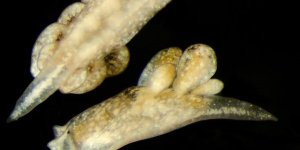| News / Science News |
"Out of Tibet" hypothesis: Cradle of evolution for cold-adapted mammals is in Tibet
NSF | JULY 20, 2014
For the last 2.5 million years, Earth has experienced millennia-long cold and warm cycles. During cold periods, continental-scale ice sheets have blanketed large tracts of the Northern Hemisphere.

The Kunlun Mountains are the highest site where fossil mammals have been found. Credit: Xiaoming Wang.
As climate warmed, glaciers receded, leaving Yosemite-like valleys and similar geologic features behind.
The advance and retreat of the ice sheets also had a profound influence on the evolution and geographic distribution of many animals, including those that live in far northern regions.
Research conducted in the Himalayan Mountains identify a recently discovered three to five million-year-old Tibetan fox, Vulpes qiuzhudingi, as the likely ancestor of the living arctic fox, Vulpes lagopus. The finding lends support to the idea that the evolution of present-day animals in the Arctic traces back to ancestors that adapted to life in cold regions in the high-altitude Tibetan Plateau.
The scientists, part of a team of geologists and paleontologists led by Xiaoming Wang of the Natural History Museum of Los Angeles County, uncovered fossil specimens of the Tibetan fox in the Zanda Basin in southern Tibet.
In addition to the fox, the team also discovered extinct species of a wooly rhino (Coelodonta thibetana), three-toed horse (Hipparion), Tibetan bharal (Pseudois, known as blue sheep), chiru (Pantholops, known as Tibetan antelope), snow leopard (Uncia), badger (Meles), and 23 other mammals.
The new fossil assemblage lends credence to a scenario the scientists call the "Out of Tibet" hypothesis.
It argues that some Ice Age megafauna--which in North America include the woolly mammoth, saber-toothed cat and giant sloth--used ancient Tibet as a training ground for developing adaptations that allowed them to cope with a harsh climate.
At the more than 14,000-foot elevation, it's difficult to breathe, water freezes overnight in camps, and the scientists often must walk alone in search of fossils. They've trained their eyes to search for ancient lake margins, where megafauna are reliably found.
Despite the challenges, Wang says that it's his favorite place to look for fossils. "It's a pristine environment, the Tibetan people are kind, and in paleontological terms," he says, "it's relatively unexplored."
YOU MAY ALSO LIKE




